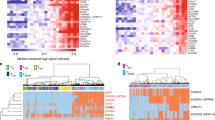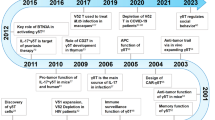Abstract
Phenotypic and functional heterogeneity are the hallmarks of effector and memory T cells. Upon antigen stimulation, γδ T cells differentiate into two major types of memory T cells: central memory cells, which patrol the blood and secondary lymphoid organs, and effector memory cells, which migrate to peripheral tissues. γδ T cells display in vitro a certain degree of plasticity in their function that is reminiscent of that which is observed in conventional CD4 T cells. Similar to CD4 T cells, in which a plethora of specialized subsets affect the host response, γδ T cells may readily and rapidly assume distinct Th1-, Th2-, Th17-, TFH and T regulatory-like effector functions, suggesting that they profoundly influence cell-mediated and humoral immune responses. In addition to differences in cytokine repertoire, γδ T cells exhibit diversity in homing, such as migration to lymph node follicles, to help B cells versus migration to inflamed tissues. Here, we review our current understanding of γδ T-cell lineage heterogeneity and flexibility, with an emphasis on the human system, and propose a classification of effector γδ T cells based on distinct functional phenotypes.
This is a preview of subscription content, access via your institution
Access options
Subscribe to this journal
Receive 12 digital issues and online access to articles
$119.00 per year
only $9.92 per issue
Buy this article
- Purchase on Springer Link
- Instant access to full article PDF
Prices may be subject to local taxes which are calculated during checkout

Similar content being viewed by others
References
Bonneville M, O'Brien RL, Born WK . γδ T cell effector functions: a blend of innate programming and acquired plasticity. Nat Rev Immunol 2010; 10: 467–478.
Dieli F, Poccia F, Lipp M, Sireci G, Caccamo N, Di Sano C et al. Differentiation of effector/memory Vδ2 T cells and migratory routes in lymph nodes or inflammatory sites. J Exp Med 2003; 198: 391–397.
Eberl M, Roberts GW, Meuter S, Williams JD, Topley N, Moser B . A rapid crosstalk of human γδ T cells and monocytes drives the acute inflammation in bacterial infections. PLoS Pathog 2009; 5: e1000308.
Vermijlen D, Ellis P, Langford C, Klein A, Engel R, Williman K et al. Distinct cytokine-driven responses of activated blood γδ T cells: insights into unconventional T cell pleiotropy. J Immunol 2007; 178: 4304–4314.
Sireci G, Champagne E, Fournié JJ, Dieli F, Salerno A . Patterns of phosphoantigen stimulation of human Vγ9Vδ2 T cell clones include Th0 cytokines. Hum Immunol 1997; 58: 70–82.
Wesch D, Glatzel A, Kabelitz D . Differentiation of resting human peripheral blood γδ T cells toward Th1- or Th2-phenotype. Cell Immunol 2001; 212: 110–117.
Ness-Schwickerath KJ, Jin C, Morita CT . Cytokine requirements for the differentiation and expansion of IL-17A- and IL-22-producing human Vγ9Vδ2 T cells. J Immunol 2010; 184: 7268–7280.
Caccamo N, La Mendola C, Orlando V, Meraviglia S, Todaro M, Stassi G et al. Differentiation, phenotype and function of interleukin-17-producing human Vγ9Vδ2 T cells. Blood 2011; 118: 129–138.
Casetti R, Agrati C, Wallace M, Sacchi A, Martini F, Martino A et al. TGF-β1 and IL-15 Induce FOXP3+ γδ regulatory T cells in the presence of antigen stimulation. J Immunol 2009; 183: 3574–3577.
Mosmann TR, Coffman RL . TH1 and TH2 cells: different patterns of lymphokine secretion lead to different functional properties. Annu Rev Immunol 1989; 7: 145–173.
Romagnani S . The Th1/Th2 paradigm. Immunol Today 1997; 18: 263–266.
Sallusto F, Geginat J, Lanzavecchia A . Central memory and effector memory T cell subsets: function, generation, and maintenance. Annu Rev Immunol 2004; 22: 745–763.
Szabo SJ, Kim ST, Costa GL, Zhang X, Fathman CG, Glimcher LH . A novel transcription factor, T-bet, directs Th1 lineage commitment. Cell 2000; 100: 655–669.
Devilder MC, Allain S, Dousset C, Bonneville M, Scotet E . Early triggering of exclusive IFN-γ responses of human Vγ9Vδ2 T cells by TLR-activated myeloid and plasmacytoid dendritic cells. J Immunol 2009; 183: 3625–3633.
Zheng W, Flavell RA . The transcription factor GATA-3 is necessary and sufficient for Th2 cytokine gene expression in CD4 T cells. Cell 1997: 89: 587–596.
Agarwal S, Rao A . Modulation of chromatin structure regulates cytokine gene expression during T cell differentiation. Immunity 1998; 9: 765–775.
Yin Z, Chen C, Szabo SJ, Glimcher LH, Ray A, Craft J . T-Bet expression and failure of GATA-3 cross-regulation lead to default production of IFN-γ by γδ T cells. J Immunol 2002; 168: 1566–1571.
Chen L, He W, Kim ST, Tao J, Gao Y, Chi H et al. Epigenetic and transcriptional programs lead to default IFN-γ production by γδ T cells. J Immunol 2007; 178: 2730–2736.
Reiner SL . Helper T cell differentiation, inside and out. Curr Opin Immunol 2001; 13: 351–355.
Sireci G, Espinosa E, Di Sano C, Dieli F, Fournié JJ, Salerno A . Differential activation of human γδ cells by nonpeptide phosphoantigens. Eur J Immunol 2001; 31: 1628–1635.
Ribot JC, deBarros A, Pang DJ, Neves JF, Peperzak V, Roberts SJ et al. CD27 is a thymic determinant of the balance between interferon-γ- and interleukin 17-producing γδ T cell subsets. Nat Immunol 2009; 10: 427–436.
Jensen KD, Su X, Shin S, Li L, Youssef S, Yamasaki S et al. Thymic selection determines γδ T cell effector fate: antigen-naive cells make interleukin-17 and antigen-experienced cells make interferon γ. Immunity 2008; 29: 90–100.
Gibbons DL, Haque SF, Silberzahn T, Hamilton K, Langford C, Ellis P et al. Neonates harbour highly active γδ T cells with selective impairments in preterm infants. Eur J Immunol 2009; 39: 1794–1806.
Kao CY, Huang F, Chen Y, Thai P, Wachi S, Kim C et al. Up-regulation of CC chemokine ligand 20 expression in human airway epithelium by IL-17 through a JAK-independent but MEK/NF-kappaB-dependent signalling pathway. J Immunol 2005; 175: 6676–6685.
Kao CY, Chen Y, Thai P, Wachi S, Huang F, Kim C et al. IL-17 markedly upregulates beta-defensin-2 expression in human airway epithelium via JAK and NF-kappaB signalling pathways. J Immunol 2004; 173: 3482–3491.
Yang D, Chertov O, Bykovskaia SN, Chen Q, Buffo MJ, Shogan J et al. β-defensins: linking innate and adaptive immunity through dendritic and T cell CCR6. Science 1999; 286: 525–528.
Pelletier M, Maggi L, Micheletti A, Lazzeri E, Tamassia N, Costantini C et al. Evidence for a cross-talk between human neutrophils and Th17 cells. Blood 2010; 115: 335–343.
Korn T, Bettelli E, Oukka M, Kuchroo VK . IL-17 and Th17 cells. Annu Rev Immunol 2009; 27: 485–517.
Fenoglio D, Poggi A, Catellani S, Battaglia F, Ferrera A, Setti M et al. Vδ1 T lymphocytes producing IFN-γ and IL-17 are expanded in HIV-1-infected patients and respond to Candida albicans. Blood 2009; 113: 6611–6618.
Messi M, Giacchetto I, Nagata K, Lanzavecchia A, Natoli G, Sallusto F . Memory and flexibility of cytokine gene expression as separable properties of human TH1 and TH2 lymphocytes. Nat Immunol 2002; 4: 78–86.
Zhou L, Lopes JE, Chong MM, Ivanov II, Min R, Victora GD et al. TGF-β-induced Foxp3 inhibits TH17 cell differentiation by antagonizing RORγt function. Nature 2008; 453: 236–240.
McGeachy MJ, Bak-Jensen KS, Chen Y, Tato CM, Blumenschein W, McClanahan T et al. TGF-β and IL-6 drive the production of IL-17 and IL-10 by T cells and restrain TH-17 cell-mediated pathology. Nat Immunol 2007; 8: 1390–1397.
Acosta-Rodriguez EV, Rivino L, Geginat J, Jarrossay D, Gattorno M, Lanzavecchia A et al. Surface phenotype and antigenic specificity of human interleukin 17-producing T helper memory cells. Nat Immunol 2007; 8: 639–646.
Duhen T, Geiger R, Jarrossay D, Lanzavecchia A, Sallusto F . Production of interleukin 22 but not interleukin 17 by a subset of human skin-homing memory T cells. Nat Immunol 2009; 10: 857–863.
Trifari S, Kaplan CD, Tran EH, Crellin NK, Spits H . Identification of a human helper T cell population that has abundant production of interleukin 22 and is distinct from TH-17, TH1 and TH2 cells. Nat Immunol 2009; 10: 864–871.
Veldhoen M, Hirota K, Christensen J, O'Garra A, Stockinger B . Natural agonists for aryl hydrocarbon receptor in culture medium are essential for optimal differentiation of Th17 T cells. J Exp Med 2009; 206: 43–49
Veldhoen M, Hirota K, Westendorf AM, Buer J, Dumoutier L, Renauld JC et al. The aryl hydrocarbon receptor links TH17-cell–mediated autoimmunity to environmental toxins. Nature 2008; 453: 106–109.
O'Garra A, Stockinger B, Veldhoen M . Differentiation of human TH-17 cells does require TGFβ. Nat Immunol 2008; 9: 588–590.
Yang L, Anderson DE, Baecher-Allan C, Hastings WD, Bettelli E, Oukka M et al. IL-21 and TGF-β are required for differentiation of human TH17 cells. Nature 2008; 454: 350–352.
Manel N, Unutmaz D, Littman DR . The differentiation of human TH-17 cells requires transforming growth factor-beta and induction of the nuclear receptor RORγt. Nat Immunol 2008; 9: 641–649.
Crotty S . Follicular helper CD4 T cells (TFH). Annu Rev Immunol 2011; 29: 621–663.
Bansal RR, Mackay CR, Moser B, Eberl M . IL-21 enhances the potential of human γδ T cells to provide B-cell help. Eur J Immunol 2012; 42: 110–119.
Caccamo N, Todaro M, La Manna MP, Sireci G, Stassi G, Dieli F . IL-21 regulates the differentiation of a human γδ T cell subset equipped with B cell helper activity. PLoS ONE 2012; 7: e41940.
Thedrez A, Harly C, Morice A, Salot S, Bonneville M, Scotet E . IL-21-mediated potentiation of antitumor cytolytic and proinflammatory responses of human Vγ9Vδ2 T cells for adoptive immunotherapy. J Immunol 2009; 182: 3423–3431.
Liang HE, Reinhardt RL, Bando JK, Sullivan BM, Ho IC, Locksley RM . Divergent expression patterns of IL-4 and IL-13 define unique functions in allergic immunity. Nat Immunol 2012; 13: 58–66.
Butcher EC, Picker LJ . Lymphocyte homing and homeostasis. Science 1996; 272: 60–66.
Sigmundsdottir H, Butcher EC . Environmental cues, dendritic cells and the programming of tissue-selective lymphocyte trafficking. Nat Immunol 2008; 9: 981–987.
Laggner U, Di Meglio P, Perera GK, Hundhausen C, Lacy KE, Ali N et al. Identification of a novel proinflammatory human skin-homing Vγ9Vδ2 T cell subset with a potential role in psoriasis. J Immunol 2011; 187: 2783–2793.
Homey B, Alenius H, Muller A, Soto H, Bowman EP, Yuan W et al. CCL27–CCR10 interactions regulate T cell-mediated skin inflammation. Nat Med 2002; 8: 157–165.
Acknowledgements
We thank Martin Lipp, Richard Kroczek and Vaclav Horejsi for providing us with reagents and Matthias Eberl, Marc Bonneville, Jean Jacques Fourniè and Emmanuel Scotet for sharing unpublished data. This work was supported by grants from the Ministry of University and Research (MIUR-PRIN 2008 to FD), the Ministry of Health ‘Ricerca Finalizzata 2007’ (to FD) and the University of Palermo.
Author information
Authors and Affiliations
Corresponding author
Rights and permissions
About this article
Cite this article
Caccamo, N., Todaro, M., Sireci, G. et al. Mechanisms underlying lineage commitment and plasticity of human γδ T cells. Cell Mol Immunol 10, 30–34 (2013). https://doi.org/10.1038/cmi.2012.42
Received:
Accepted:
Published:
Issue Date:
DOI: https://doi.org/10.1038/cmi.2012.42
Keywords
This article is cited by
-
Classification and function of γδT cells and its research progress in anti-glioblastoma
Discover Oncology (2023)
-
Vitamin C as a promoter of γδ T cells
Cellular & Molecular Immunology (2021)
-
Decidual RANKL/RANK interaction promotes the residence and polarization of TGF-β1-producing regulatory γδ T cells
Cell Death & Disease (2019)
-
Downregulation of miRNA17–92 cluster marks Vγ9Vδ2 T cells from patients with rheumatoid arthritis
Arthritis Research & Therapy (2018)
-
Human regulatory γδT cells and their functional plasticity in the tumor microenvironment
Cellular & Molecular Immunology (2018)



